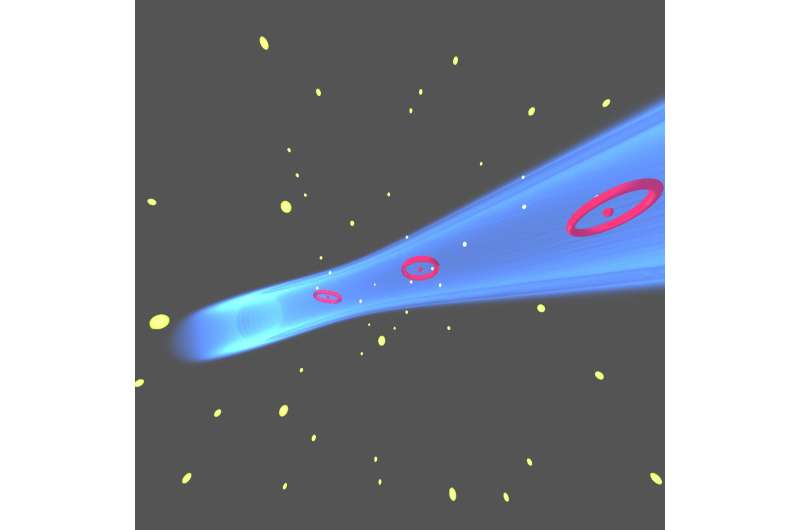April 8, 2020 feature
First successful laser trapping of circular Rydberg atoms

Rydberg atoms, which are atoms in a highly excited state, have several unique and advantageous properties, including a particularly long lifetime and large sensitivities to external fields. These properties make them valuable for a variety of applications, for instance for the development of quantum technologies.
In order for Rydberg atoms to be effectively used in quantum technology, however, researchers first need to be able to trap them. While a number of studies have demonstrated the trapping of Rydberg atoms using magnetic, electric, or laser technology, the trapping times achieved so far have been relatively short, typically around 100μs.
Researchers at Laboratoire Kastler Brossel (LKB) have recently achieved a longer 2-D laser trapping time of circular Rydberg atoms of up to 10 ms. The method they employed, outlined in a paper published in Physical Review Letters, could open up exciting new possibilities for the development of quantum technology.
"Our research group at LKB is one of the few worldwide that can prepare and manipulate circular Rydberg levels of atoms," Clément Sayrin, one of the researchers who carried out the study, told Phys.org. "Our group has actually a long experience in working with circular Rydberg atoms, which roots back to the 1970s/1980s and the work of Serge Haroche. A significant part of our research activities is now devoted to the use of these atoms in quantum technologies."
Most quantum simulators employing Rydberg atoms developed to date use non-circular Rydberg atoms. These technologies were first pioneered by a research group at Institut d'Optique Graduate School (IOGS) in Palaiseau, led by Antoine Browaeys and Thierry Lahaye, as well as by a team at Harvard led by Mikhail Lukin.
While these simulators have achieved remarkable results, their capabilities have been limited by the fact that the Rydberg atoms inside them were not trapped and thus continued to move as the system operated. The new study conducted by Sayrin, Michel Brune (director of research), Rodrigo Cortiñas (Ph.D. student), Maxime Favier (post-doctoral student) and other researchers at LKB introduces a solution to this problem that entails the use of circular Rydberg atoms (i.e., atoms in Rydberg circular states) and a technique known as laser trapping.
"When an atom is excited to a circular Rydberg level, it can be fairly described as an electron that orbits far from the nucleus on a circular orbit, an orbit almost as large as a bacterium," Sayrin explained. "Hence, the electron is almost free and free electrons, as any charged particle, are repelled by intense light fields."
The researchers essentially leveraged the fact that circular Rydberg atoms are repelled by intense light to trap the atoms. To achieve this, they produced a donut-shaped light beam, more specifically a round laser beam with a dark spot at its center, where the atoms would ultimately be trapped.
"If an electron is at the center of the donut, it cannot escape from it: it is trapped in the light beam," Sayrin explained. "The heavy nucleus then just follows, attracted by the electron via the Coulomb interaction! Somehow, we trap the circular Rydberg atom by grabbing it by its electron."
Sayrin and his colleagues produced the donut-shaped beam using a tool known as a spatial light modulator (SLM). SLMs are objects that can imprint phase patterns on light beams, which in turn modifies the shape of these beams. These unique tools were once widely used in video projectors to reflect images or videos onto surfaces.
"Somehow, we have made our own video projector to produce the donut beam, but instead of a light bulb as source, we have a powerful infrared laser, and instead of a screen we shine the image on the Rydberg atoms," Sayrin said.
So far, researchers worldwide have only been able to demonstrate early signatures of the laser trapping of non-circular atoms, which lasted no more than a few microseconds. Circular Rydberg atoms, on the other hand, had never been laser trapped before.
The recent study by Sayrin and his colleagues shows that circular Rydberg atoms can, in fact, be laser trapped and for remarkably longer timescales. So far, the researchers were able to trap these atoms for approximately 10 milliseconds, yet this trapping time could be increased further in future studies.
"We have also showed that trapping the circular Rydberg atoms does not affect their properties (e.g., lifetime, purity, and quantum coherence)," Sayrin said. "In particular, it confirms the fact that circular Rydberg atoms are immune to photo-ionization, contrarily to other Rydberg levels."
The results could have numerous important implications for the development of quantum technologies, including tools for quantum simulation, sensing, and information processing. In fact, effectively keeping circular Rydberg atoms in place while quantum systems are operating, as demonstrated in their study, means that these atoms could be used for longer times. This may ultimately boost the performance of different quantum technologies, for instance enhancing the sensitivity of sensors, increasing the simulation time of simulators, and so on.
Sayrin and his colleagues are now planning to realize an array of laser-trapped circular Rydberg atoms. To achieve this, they will prepare an array of optical tweezers with a hole in its center, a structure known as 'bottle beam trap."
"By trapping one and only one circular Rydberg atom in every bottle, separated by a few microns, we will produce a regular array of interacting circular Rydberg atoms," Sayrin explained. "This will realize a quantum simulator of interacting spins that should allow us to run simulations over unprecedented time scales."
More information: R. G. Cortiñas et al. Laser Trapping of Circular Rydberg Atoms, Physical Review Letters (2020). DOI: 10.1103/PhysRevLett.124.123201
Journal information: Physical Review Letters
© 2020 Science X Network


















